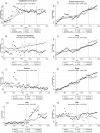Changes in apparent consumption of staple food in Mexico associated with the gradual implementation of the NAFTA
- PMID: 36962675
- PMCID: PMC10021749
- DOI: 10.1371/journal.pgph.0001144
Changes in apparent consumption of staple food in Mexico associated with the gradual implementation of the NAFTA
Abstract
In 1994, the United States, Canada, and Mexico signed the North American Free Trade Agreement (NAFTA) to remove trade barriers and facilitate cross-border trade in goods and services. Worldwide, trade agreements, urbanization and economic development have shaped significant changes in dietary habits. This study aims to evaluate the association between the gradual implementation of NAFTA and changes in apparent consumption of staple foods in Mexico. We analyzed national apparent consumption of animal- and vegetable-source foods, using data from the Food and Agriculture Organization of the United Nations (FAO) from 1970 to 2018. Association between NAFTA and apparent consumption was estimated using interrupted time series analysis (ITSA) with synthetic controls and included two inflection points based on the implementation of NAFTA: 1994, when the agreement began, and 2008 when it was fully implemented. As a result, comparing Mexico with the synthetic control, we found a significant decrease in apparent consumption of pulses, -3.22 and -1.92 kcal/capita/day in the post-1994 and post-2008 periods, respectively. The vegetable-source foods showed an increase of 5.79 kcal/capita/day after 2008. The trends of apparent consumption of animal-source foods, eggs, and milk had significant increases after 1994 and 2008. The apparent consumption of meat increased only after 2008. The implementation of NAFTA was associated with an increase in apparent consumption of food from animal-source and a decrease in consumption of pulses. After 2008, an increase in apparent consumption of vegetable-source foods was observed.
Copyright: © 2022 Sánchez-Ortiz et al. This is an open access article distributed under the terms of the Creative Commons Attribution License, which permits unrestricted use, distribution, and reproduction in any medium, provided the original author and source are credited.
Conflict of interest statement
The authors have declared that no competing interests exist.
Figures

Similar articles
-
Estimating the unintended impact of the North American free trade agreement on U.S. public health.Soc Sci Med. 2023 Sep;333:116140. doi: 10.1016/j.socscimed.2023.116140. Epub 2023 Aug 8. Soc Sci Med. 2023. PMID: 37573675
-
Impact of the North American Free Trade Agreement on high-fructose corn syrup supply in Canada: a natural experiment using synthetic control methods.CMAJ. 2017 Jul 4;189(26):E881-E887. doi: 10.1503/cmaj.161152. CMAJ. 2017. PMID: 28676578 Free PMC article.
-
USMCA (NAFTA 2.0): tightening the constraints on the right to regulate for public health.Global Health. 2019 May 14;15(1):35. doi: 10.1186/s12992-019-0476-8. Global Health. 2019. PMID: 31088499 Free PMC article. Review.
-
[NAFTA: a challenge and an opportunity for environmental health. The case of the maquila industry].Salud Publica Mex. 1994 Nov-Dec;36(6):597-616. Salud Publica Mex. 1994. PMID: 7892636 Spanish.
-
Review: Trends for meat, milk and egg consumption for the next decades and the role played by livestock systems in the global production of proteins.Animal. 2021 Dec;15 Suppl 1:100287. doi: 10.1016/j.animal.2021.100287. Epub 2021 Jul 24. Animal. 2021. PMID: 34312092 Review.
References
-
- Popkin BM. Urbanization, Lifestyle Changes and the Nutrition Transition. World development. 1999. Nov;27(11):1905–16. Available from: https://linkinghub.elsevier.com/retrieve/pii/S0305750X99000947.
-
- Popkin BM G-LP. The nutrition transition: worldwide obesity dynamics and their determinants. Int J Obes Relat Metab Disord. 2004;28(3):2–9. - PubMed
LinkOut - more resources
Full Text Sources
Research Materials
